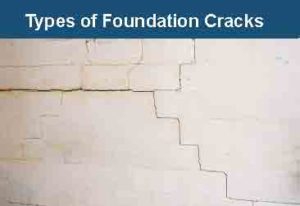Wet Basements – Cracks And Water Leaks
A typical basement is constructed of am 18 inch footing that supports the basement walls and floor. The footing must rest on solid or undisturbed soil. If the footing is on wet soil it is required to be 36 inches wide. The wall may be constructed of cement block, poured concrete, brick, stone or even wood. In the past 80 years, most foundation walls have been constructed of cement block or poured concrete. Many custom homes now use the ICF type of construction for greater insulation value. The floor is poured concrete supported on the edges by the footing and in the center by compacted gravel. There are many types of Foundation Cracks and which may or not be serious enough for a required repair.
constructed of cement block, poured concrete, brick, stone or even wood. In the past 80 years, most foundation walls have been constructed of cement block or poured concrete. Many custom homes now use the ICF type of construction for greater insulation value. The floor is poured concrete supported on the edges by the footing and in the center by compacted gravel. There are many types of Foundation Cracks and which may or not be serious enough for a required repair.
Basement – Tarion Warranty
New home buyers are covered by Tarion Warranty for water leaking into the basement. Tarion will cover any water leakage for 2 years from date of possession. The majority of foundation cracks are typically due to drying shrinkage, thermal movement or other causes which are usually are minor in nature and result in few issues. Occasionally a foundation crack will widen over time and result in water seepage or possibly the loss of structural integrity. Foundation and slab cracks are not only an eyesore, but they may hinder the resale value of the home.
To help determine where water or moisture is coming from you can simply tape a piece of aluminum foil to suspect area. Moisture on the outside surface of the foil indicates high indoor humidity. Moisture behind the foil means moisture is leaking through the walls.
Basement Floors
Cracks in the floor or the space left where the floor meets the wall (called the cove joint) rarely, if ever, leak as long as the sump system and weeping tile system are working properly. On occasion, the cove joint can show signs of moisture in areas a great distance from the pump or in alcoves or bays. This joint can be injected with urethane and, when cured, repel the water long enough to allow it to drain. This is assuming the weeping tile is not blocked. Cracks in the floor should never leak. If water is coming up through floor cracks, the pump may not be working or the weeping tile has a blockage. In Ontario every home is required to have a sump pump or alternative method of draining water. In Toronto and larger cities any weeping tile would drain into Storm Drains.
moisture in areas a great distance from the pump or in alcoves or bays. This joint can be injected with urethane and, when cured, repel the water long enough to allow it to drain. This is assuming the weeping tile is not blocked. Cracks in the floor should never leak. If water is coming up through floor cracks, the pump may not be working or the weeping tile has a blockage. In Ontario every home is required to have a sump pump or alternative method of draining water. In Toronto and larger cities any weeping tile would drain into Storm Drains.
Hole in Basement Walls
Rod holes are created by the contractor when securing his forms together. In order to hold the concrete forms together and to prevent bulging from the weight of wet concrete, 5/8″ steel rods are connected through the forms from one side to the other. After the concrete is poured, the forms are stripped off and the rods are removed leaving a 5/8″ hole passing right through your foundation wall. The holes are then patched with a dollop of hydraulic cement or non-shrink grout on the inside and the outside.
WET Basements
Basement flooding is a problem for any homeowner. Aside from making your basement unusable, a basement flood can ruin your flooring and furniture and create a serious health and safety hazard. If you have water in your basement, you need answers: what caused the flood and how can you stop it from happening again? There maybe a simple fix to your problem or it may be more complex and require a professional company to make some repairs. In over 8,000 home inspections I have found that most wet basements are caused by either, poor landscaping or problems with downspouts.
Some basement water problems occasionally arise during the construction process and disappear when a home’s drainage system is fully functional. There are three basic causes of seepage and cracks in basements. First, the original workmanship may be poor. Second, the house may have settled, causing cracks in either the floor or walls. Finally, water pressure from the outside may have built up and be forcing water through the walls. Read more about Concrete Foundation Cracks and How they can affect your Home
Many basement water problems are created by poor grading or improper drainage. Your roof alone can discharge 1500 L per hour in a heavy downpour which may be distributed into an average of 4 downspouts. These downspouts should be extended to ensure that water is directed away from your home and not collecting against your home’s foundation. Many homeowners will build sidewalks or planters which will impede or even collect water from rain, snow and downspout discharge. This water will eventually find its way through your basement wall in the form of moisture or even a water leak. Simple maintenance of downspouts and landscaping will prevent most common basement water issues.
If your basement leaks after heavy rains or after snow melts, make sure water is diverted away from your foundation which may solve your problem. It’s common for the soil alongside your house to settle over time, creating a low area that collects runoff and directs it down your foundation wall and into the basement. Typically, a 2-inch drop for every 6 feet is minimum grade required for proper drainage.
The next heavy rain storm you have, grab your umbrella and take a walk around your house, inspecting where water is pooling or draining to. This can help you come up with a water management plan which will help keep your basement dry.
Common Home Inspection deficiencies found in Barrie and local area. Check these common items and check your own home to see if they exist in your home.
WETT Certified Inspections
There are three levels of WETT Inspections, Level 1, 2 and 3. If you are purchasing a home in Orillia, then your insurance company will require a Level 1 Inspection. Homes being purchased in almost all cases have no known history of how the wood burning system was used, the wood burned, how hot it was burned (high heat can damage the system), when it was last maintained or even cleaned. When the history of a home is unknown we always recommend having chimney cleaned to ensure there are no hidden defects.
history of how the wood burning system was used, the wood burned, how hot it was burned (high heat can damage the system), when it was last maintained or even cleaned. When the history of a home is unknown we always recommend having chimney cleaned to ensure there are no hidden defects.
Visit Orillia WETT Inspection website for more information. Read about Chimney Inspections.
Roger Frost provides WETT Certified Inspections on Wood Stoves, Fireplaces, Pellet Stoves, Wood Burning Furnaces, Fireplace Inserts and Outside Boilers. Book your professional WETT Inspection | report issued at time of inspection | WETT Inspection service provided within 48 hours in most cases.
